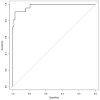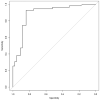The Multidimensional Assessment for Pediatric Patients in Radiotherapy (M.A.P.-RT) Tool for Customized Treatment Preparation: RADAR Project
- PMID: 33854964
- PMCID: PMC8039366
- DOI: 10.3389/fonc.2021.621690
The Multidimensional Assessment for Pediatric Patients in Radiotherapy (M.A.P.-RT) Tool for Customized Treatment Preparation: RADAR Project
Abstract
Aims: Pediatric patients may experience considerable distress during radiotherapy. Combining psychological interventions with standard therapies can reduce the need for sedation. The RADAR Project aims to use a systematic method of recording data that can reveal patients' difficulties and fragility during treatment. In this context, the aim of our study was to investigate the ability of a multidimensional assessment tool (M.A.P.-RT schedule) to predict the need for sedation during radiotherapy. The schedule, which is administered during the first evaluation, was created to collect information on patients and their families in a standardized way. Materials and Methods: The study enrolled pediatric patients (aged 0-18 years or 18-21 with cognitive impairment). Data were collected by means of the M.A.P.-RT module; this explores various thematic areas, and is completed by the radiation oncologist, psychologist and nurse during their first evaluation. Features were selected by means of the Boruta method (random forest classifier), and the totals of the significant partial scores on each subsection of the module were inserted into a logistic model in order to test for their correlation with the use of anesthesia and with the frequency of psychological support. The results of logistic regression (LR) were used to identify the best predictors. The AUC was used to identify the best threshold for the scores in the evaluation. Results: A total of 99 patients were considered for this analysis. The feature that best predicted both the need for anesthesia and the frequency of psychological support was the total score (TS), the AUC of the ROC being 0.9875 for anesthesia and 0.8866 for psychological support. Conclusion: During the first evaluation, the M.A.P.-RT form can predict the need for anesthesia in pediatric patients, and is a potential tool for personalizing therapeutic and management procedures.
Keywords: anesthesia; children; distress; pediatrics; psychological support; radiotherapy.
Copyright © 2021 Chiesa, Marconi, Dinapoli, Sanfilippo, Ruggiero, Mastronuzzi, Panza, Serra, Massaccesi, Cacchione, Beghella Bartoli, Chieffo, Gambacorta, Valentini and Balducci.
Conflict of interest statement
The authors declare that the research was conducted in the absence of any commercial or financial relationships that could be construed as a potential conflict of interest.
Figures






Similar articles
-
Prospective evaluation of propofol anesthesia in the pediatric intensive care unit for elective oncology procedures in ambulatory and hospitalized children.Pediatrics. 2000 Oct;106(4):742-7. doi: 10.1542/peds.106.4.742. Pediatrics. 2000. PMID: 11015517
-
Comparison of propofol/fentanyl versus ketamine/midazolam for brief orthopedic procedural sedation in a pediatric emergency department.Pediatrics. 2003 Jul;112(1 Pt 1):116-23. doi: 10.1542/peds.112.1.116. Pediatrics. 2003. PMID: 12837876 Clinical Trial.
-
Behavioral techniques to optimize success of in-office pediatric tympanostomy tube placement without sedation.Int J Pediatr Otorhinolaryngol. 2015 Dec;79(12):2170-3. doi: 10.1016/j.ijporl.2015.09.041. Epub 2015 Oct 8. Int J Pediatr Otorhinolaryngol. 2015. PMID: 26514928 Clinical Trial.
-
A systematic review of interventions to reduce psychological distress in pediatric patients receiving radiation therapy.Patient Educ Couns. 2019 Feb;102(2):275-283. doi: 10.1016/j.pec.2018.09.023. Epub 2018 Sep 29. Patient Educ Couns. 2019. PMID: 30318385
-
[ADI-R and ADOS and the differential diagnosis of autism spectrum disorders: Interests, limits and openings].Encephale. 2019 Nov;45(5):441-448. doi: 10.1016/j.encep.2019.07.002. Epub 2019 Sep 5. Encephale. 2019. PMID: 31495549 Review. French.
Cited by
-
Psychosocial needs of post-radiotherapy cancer survivors and their direct caregivers - a systematic review.Front Oncol. 2023 Oct 26;13:1246844. doi: 10.3389/fonc.2023.1246844. eCollection 2023. Front Oncol. 2023. PMID: 37954077 Free PMC article.
-
Supporting paediatric patients to receive radiation therapy without sedation or general anaesthetic.J Med Radiat Sci. 2023 Dec;70(4):357-359. doi: 10.1002/jmrs.734. Epub 2023 Oct 25. J Med Radiat Sci. 2023. PMID: 37880876 Free PMC article.
-
Use of artificial intelligence in paediatric anaesthesia: a systematic review.BJA Open. 2023 Feb 7;5:100125. doi: 10.1016/j.bjao.2023.100125. eCollection 2023 Mar. BJA Open. 2023. PMID: 37587993 Free PMC article. Review.
-
Allies not enemies-creating a more empathetic and uplifting patient experience through technology and art.Strahlenther Onkol. 2025 Mar;201(3):316-332. doi: 10.1007/s00066-024-02279-7. Epub 2024 Sep 11. Strahlenther Onkol. 2025. PMID: 39259348 Free PMC article. Review.
-
Integration of art and technology in personalized radiation oncology care: Experiences, evidence, and perspectives.Front Public Health. 2023 Jan 23;11:1056307. doi: 10.3389/fpubh.2023.1056307. eCollection 2023. Front Public Health. 2023. PMID: 36755901 Free PMC article.
References
-
- Pisani P, Buzzoni C, Crocetti E, Dal Maso L, Rondelli R, Alessi D. Italian Cancer Figures - Report 2012 Cancer in children and adolescents AIRTUM Working Group and AIEOP Working Group. Epidemiol Prev. (2013) 37:1–296. - PubMed
LinkOut - more resources
Full Text Sources
Other Literature Sources

